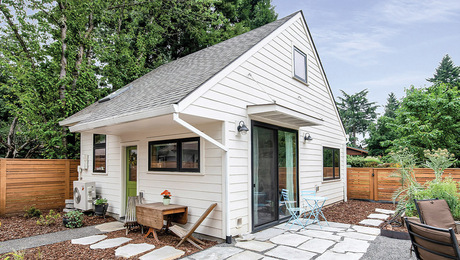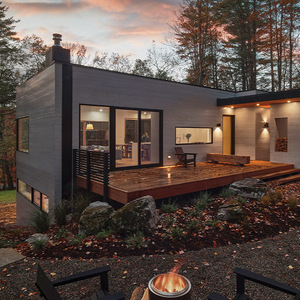Does anyone know of a site that shows how a ‘drain tile’ system works? I understand the concept that you want perforated tubes (PVC?) laid in gravel on all four sides of the foundation. But are they all sloped towards one corner of the house? And if so how do they get from that corner into the sump pump basket?
We’re building a new home and I don’t ‘think’ we’re going to have any drainage problems but some experienced guys have told me to put a sump in just in case.
Thanks,
Rob



















Replies
Lucky,
The first line of defense against water in the basement is an exterior system that allows water to run down to an exterior perimeter drain pipe. The pipe has (typically) 2 rows of holes and is laid so the rows are at 5 O'clock and 7 O'clock. this pipe can be level or can have a 1/8"per foot (1%) slope-to-drain. It should drain to "open air".
The second line of defense is to set 3" or 4" PVC "weeps" about 6' to 8' O.C. in the wall slightly above the bottom of the exterior drain pipe. These "weeps" are open to the drain "burrito" (lay landscape cloth, 2"-6" gravel, the exterior drain pipe, 12" gravel, and wrap the landscape cloth around the top of the garvel.) On the inside of the footing, under the slab and drain gravel (3"-6") connect the "weeps" to the interior drain pipe, and run that pipe to your sump pit. The interior pipe can also be level or sloped at 1%.
If you set the exterior drain below the top of the footing and the "weeps" on the footing, the relative elevations will work great.
The ground and air can absorb any water that does not make it out if you set the drain pipes level.
I prefer to set a third line and water proof the cement walls themselves.
SamT
here is one url that will explain it.
http://www.jlcnet.com/banner/basep4.html
We always use perimeter drains both inside and outside. I prefer the type with a silt cover. If you dig a hole water will find a way to go there. A positive drain is the most desirable. Natural gravity run off no pump needed. We do put in a pump hole where the drains all connect. Your pipe supply will have some "buckets" made just for this application with covers. In the last few years I have built two houses that had water problems. Same town but a half mile apart. The lots did not allow a positive drain. Pumping into the sewer system or storm drains was prohibited. A sistern or drywell would be overwhelmed. The only place to pump was the neighbors or the street. An underground vein or spring on each location was apparantly disturbed and found its way into these basements. Cold clear water runs 24/7. Pumps would burn out and if the power went out you had a swimming pool. On one after pumping out toward the street a two foot glacier took form about this time of year and started down the road. The town had to send up a crew with a grader to clear the road. We got a special dispensation to connect to the storm drain and achieved our positive drain that week. On the other we had to get an easement to allow us to run underground to a drainage area. The water still runs but under control. In some areas radon gas is also an issue and is vented in a similar manner. Collection pipes run under the slab and are power vented to the exterior.
If there is anyway possible to get the draintiles that are on the exterior of the foundation to exit to daylight rather than connecting to tiles under the basement slab, do it, even if you have to dig a 100' ditch. Use min schedule 30 PVC, 4" or larger for the draintail(s) to prevent them from being crushed during construction or after move-in. When I say "draintail" I mean the drain pipe that drains water away from the foundation drain system and out into the yard.
If you're building a new house, I really like this stuff:
http://www.deltams.com/deltams/index.html
It's waterproofing, not drain tile. But it's good stuff.
If one less person had put out one less percent we would have lost. [Tommy Prothro]
The other responders are more expert than I but a couple of details you might want to know/investigate:
1. The holes in the pipe go down, not up, on top of a few inches of gravel.
2. Install a cleanout at the back end of every pipe using a 45 degree angle.
3. Depending on what part of the country you're in this last comment might not matter. If you're on expansive soils watch out for the sump pump you can cause differential settlement if you use a sump. The passive system described by the other folks of the drain cloth, gravel and perforated pipe is generally considered more benign. If you're really worried about this a consult with a geotechnical engineer can provide real peace of mind.
Never Connect the interior and exterior drainage!
Exterior should rum to daylight or a drywell.
Interior should run to a sump pit and be pumped into the septic system.
If the exterior (which will be doing the majority of the "work" ever clogs you don't want water backing up to the inside!!!!!!
Mr T
Do not try this at home!
I am an Experienced Professional!
Running the exterior to a dry well is great, if your soil conditions allow it. But that doesn't work everywhere.
Around here, I've water table within 4' of the surface during wet weather. So a dry well wouldn't be dry for long.
And I see absolutly no advantage with sending the interior drainage to the septic system.
It don't need treating and why burden the system with the extra water.
If it is enough water to seriously burden your septic system then your exterior drainage is not working properly, or you need a rudder not a basement!Mr T
Do not try this at home!
I am an Experienced Professional!